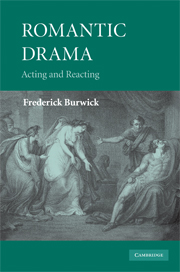Book contents
- Frontmatter
- Contents
- List of illustrations
- Acknowledgments
- Introduction
- 1 Periscopes into the theatre
- 2 Nationalism and national character
- 3 Genre: the realism of fantasy, the fantasy of realism
- 4 Acting: histrionics, and dissimulation
- 5 Transvestites, lovers, monsters: character and sexuality
- 6 Setting: where and elsewhere
- 7 Gothic and anti-Gothic: comedy and horror
- 8 Blue-Beard's castle: mischief and misogyny
- 9 Vampires in kilts
- Notes
- Bibliography
- Index
1 - Periscopes into the theatre
Published online by Cambridge University Press: 04 August 2010
- Frontmatter
- Contents
- List of illustrations
- Acknowledgments
- Introduction
- 1 Periscopes into the theatre
- 2 Nationalism and national character
- 3 Genre: the realism of fantasy, the fantasy of realism
- 4 Acting: histrionics, and dissimulation
- 5 Transvestites, lovers, monsters: character and sexuality
- 6 Setting: where and elsewhere
- 7 Gothic and anti-Gothic: comedy and horror
- 8 Blue-Beard's castle: mischief and misogyny
- 9 Vampires in kilts
- Notes
- Bibliography
- Index
Summary
An exhibition, Theatrum mundi: die Welt als Bühne (Theatrum mundi: the World as Stage), was on display in Munich at the Haus der Kunst, May 24 to September 21, 2003. The occasion for the exhibition, curated by Ulf Küster, was the 350th Anniversary of the Bavarian State Opera. With an historical emphasis on the seventeenth and eighteenth centuries, the collection included portraits of performers, theatre paintings of performances, historical costumes, stage settings, mechanical devices for a variety of special effects, and architectural plans for many of the great playhouses of Europe. Along with the architectural plans were exhibited scale models of the theatres. Protected in plastic cases, these models were not only open-roofed, so that spectators could peer into the interior; they were also equipped with periscopes, which provided the viewer with an interior perspective, as if occupying one of the best seats and able, with a turn of the periscope, to peer about in all directions.
To achieve a similar periscopic view into the theatre of the Romantic Era, the present and ensuing chapters on Romantic drama draw on the eye-witness reports of several theatre critics, most persistently on the observations of John Waldie (1781–1865). Already smitten with the theatre in early youth at the family estate at Hendersyde Park, Kelso, Roxburghshire, Waldie attended as a young boy the French theatre at the Kelso inn, the Cross-Keys, where officers among the French prisoners performed. In January, 1799, he commenced his studies at the University of Edinburgh.
- Type
- Chapter
- Information
- Romantic DramaActing and Reacting, pp. 14 - 32Publisher: Cambridge University PressPrint publication year: 2009



